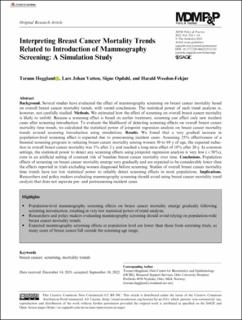| dc.contributor.author | Heggland, Torunn | |
| dc.contributor.author | Vatten, Lars Johan | |
| dc.contributor.author | Opdahl, Signe | |
| dc.contributor.author | Weedon-Fekjær, Harald | |
| dc.date.accessioned | 2023-02-09T12:47:19Z | |
| dc.date.available | 2023-02-09T12:47:19Z | |
| dc.date.created | 2022-10-24T12:54:45Z | |
| dc.date.issued | 2022 | |
| dc.identifier.citation | Medical Decision Making Policy & Practice. 2022, 7 (2), . | en_US |
| dc.identifier.issn | 2381-4683 | |
| dc.identifier.uri | https://hdl.handle.net/11250/3049725 | |
| dc.description.abstract | Background. Several studies have evaluated the effect of mammography screening on breast cancer mortality based on overall breast cancer mortality trends, with varied conclusions. The statistical power of such trend analyses is, however, not carefully studied. Methods. We estimated how the effect of screening on overall breast cancer mortality is likely to unfold. Because a screening effect is based on earlier treatment, screening can affect only new incident cases after screening introduction. To evaluate the likelihood of detecting screening effects on overall breast cancer mortality time trends, we calculated the statistical power of joinpoint regression analysis on breast cancer mortality trends around screening introduction using simulations. Results. We found that a very gradual increase in population-level screening effect is expected due to prescreening incident cases. Assuming 25% effectiveness of a biennial screening program in reducing breast cancer mortality among women 50 to 69 y of age, the expected reduction in overall breast cancer mortality was 3% after 2 y and reached a long-term effect of 18% after 20 y. In common settings, the statistical power to detect any screening effects using joinpoint regression analysis is very low (<50%), even in an artificial setting of constant risk of baseline breast cancer mortality over time. Conclusions. Population effects of screening on breast cancer mortality emerge very gradually and are expected to be considerably lower than the effects reported in trials excluding women diagnosed before screening. Studies of overall breast cancer mortality time trends have too low statistical power to reliably detect screening effects in most populations. Implications. Researchers and policy makers evaluating mammography screening should avoid using breast cancer mortality trend analysis that does not separate pre- and postscreening incident cases. | en_US |
| dc.language.iso | eng | en_US |
| dc.publisher | SAGE Publications | en_US |
| dc.rights | Navngivelse-Ikkekommersiell 4.0 Internasjonal | * |
| dc.rights.uri | http://creativecommons.org/licenses/by-nc/4.0/deed.no | * |
| dc.title | Interpreting Breast Cancer Mortality Trends Related to Introduction of Mammography Screening: A Simulation Study | en_US |
| dc.title.alternative | Interpreting Breast Cancer Mortality Trends Related to Introduction of Mammography Screening: A Simulation Study | en_US |
| dc.type | Peer reviewed | en_US |
| dc.type | Journal article | en_US |
| dc.description.version | publishedVersion | en_US |
| dc.source.pagenumber | 0 | en_US |
| dc.source.volume | 7 | en_US |
| dc.source.journal | Medical Decision Making Policy & Practice | en_US |
| dc.source.issue | 2 | en_US |
| dc.identifier.doi | 10.1177/23814683221131321 | |
| dc.identifier.cristin | 2064380 | |
| cristin.ispublished | true | |
| cristin.fulltext | original | |
| cristin.qualitycode | 1 | |

